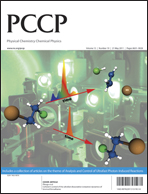Dissipative dynamics within the electronic friction approach: the femtosecond laser desorption of H2/D2 from Ru(0001)
Abstract
An electronic friction approach based on Langevin dynamics is used to describe the multidimensional (six-dimensional) dynamics of femtosecond laser induced desorption of H2 and D2 from a H(D)-covered Ru(0001) surface. The paper extends previous reduced-dimensional models, using a similar approach. In the present treatment forces and frictional coefficients are calculated from periodic density functional theory (DFT) and essentially parameter-free, while the action of femtosecond laser pulses on the metal surface is treated by using the two-temperature model. Our calculations shed light on the performance and validity of various adiabatic, non-adiabatic, and Arrhenius/Kramers type kinetic models to describe hot-electron mediated photoreactions at metal surfaces. The multidimensional frictional dynamics are able to reproduce and explain known experimental facts, such as strong isotope effects, scaling of properties with laser fluence, and non-equipartitioning of vibrational, rotational, and translational energies of desorbing species. Further, detailed predictions regarding translations are made, and the question for the controllability of photoreactions at surfaces with the help of vibrational preexcitation is addressed.

- This article is part of the themed collection: Analysis and Control of Ultrafast Photon-Induced Reactions

 Please wait while we load your content...
Please wait while we load your content...